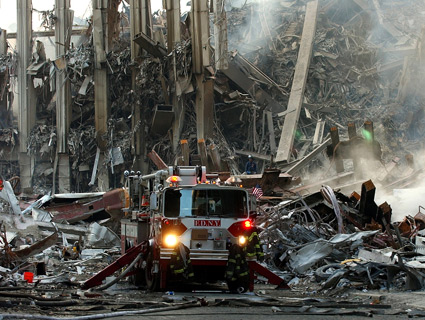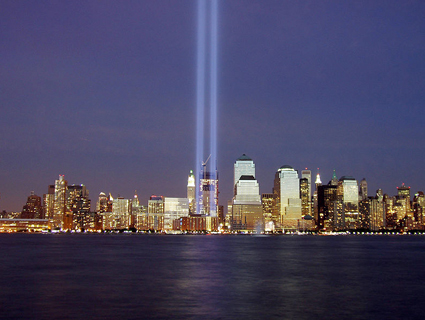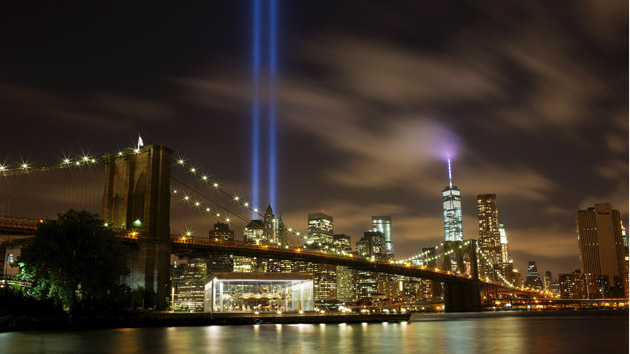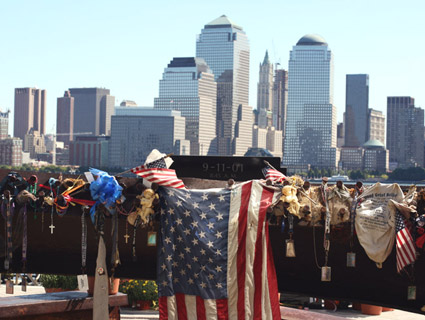
<a href="http://www.flickr.com/photos/slagheap/243447330/">Eric J. Tilford/US Navy</a>/Flickr
This story first appeared on the ProPublica website. It was co-published with the Guardian.
In the dark and uncertain days after Sept. 11, 2001, the sight of thousands of shaken New Yorkers returning to their apartments, offices and schools in Lower Manhattan seemed to signal a larger return to normalcy.
Now new documents have emerged showing that federal officials in Washington and New York went further than was previously known to downplay concerns about health risks, misrepresenting or concealing information that ultimately might have protected thousands of people from the contaminated air at ground zero.
In one instance, a warning that people should not report to work on a busy thoroughfare in the financial district—Water Street—was rewritten and workers instead were urged to return to their offices as soon as the financial district opened on Sept. 17. In another, federal officials declared that testing showed the area was safe when sampling of the air and dust—which ultimately found very high levels of toxic chemicals—had barely begun.
The documents do not reveal how—or whether—federal officials explicitly weighed the competing goals of ensuring New Yorkers’ safety and projecting an image of a city and nation unbowed. But taken as a whole, the records—which include email messages from the White House’s Council on Environmental Quality to the Environmental Protection Agency and the Occupational Safety and Health Administration, as well as interagency correspondence—give the most detailed account yet of how officials kept potentially disturbing data about health risks from the public.
Last year, Congress approved $4.3 billion to treat and compensate people with health issues related to exposure to ground zero dust.
“The misleading communications by civic leaders and their failure to insist on respiratory protection in the days, weeks and months after the initial rescue operation ended undoubtedly contributed and will continue to contribute to sickness in the rescue and recovery workers and in the citizens of Lower Manhattan,” said Dr. Philip J. Landrigan, chairman of the Department of Community and Preventative Medicine at the Mount Sinai School of Medicine. Mount Sinai has screened more than 25,000 ground zero responders for illnesses suspected of being related to the dust and treated many of them.
In response to questions about the way the disaster was handled, the EPA issued this statement: “The federal response to 9/11 has been thoroughly examined, including by EPA’s own Inspector General. What is clear is that dedicated EPA staff worked tirelessly under nearly impossible conditions to respond to an unprecedented disaster.” The statement goes on to note that the events of 9/11 tested the agency in many ways “and it is clear that some things could have been done better. Our focus every day since 9/11 has been on working to improve and expand our capacity to respond to emergencies.”
As the 10-year anniversary of 9/11 approaches, questions continue to arise over the way government agencies assessed risks at ground zero and communicated what they knew to the public. In some respects, the documents examined by ProPublica, which were obtained through Freedom of Information requests filed by the New York Committee for Occupational Safety and Health (NYCOSH), a labor union health group, expand upon what’s come out before about the White House’s role in shaping the information about ground zero contamination.
In 2003, the EPA Inspector General issued a scathing report outlining how the agency recast some of its public communications at the behest of the White House Council on Environmental Quality, a branch of the Executive Office of the President. The report concluded that the White House had at least indirectly influenced the wording of some statements by removing cautionary language about air safety downtown. It also found that the EPA had gone beyond what it knew in making general statements about the air in the first weeks after the attacks. In particular, the report harshly criticized Christine Todd Whitman, the EPA administrator in 2001, for telling people in New York that the “air is safe to breathe” before she had the facts to back it up.
Whitman declined to comment on the newly released documents. But in 2007, she strongly defended her agency before a congressional committee investigating the 9/11 response.
“It’s utterly false then for EPA critics to assert that I or others at the agency set about to mislead New Yorkers and rescue workers,” Whitman told the House Judiciary Subcommittee on the Constitution, Civil Rights and Civil Liberties, whose chairman, Rep. Jerrold Nadler, D-N.Y., represents the area around ground zero. “Every statement I made was based on what experts, who had a great deal of experience in these things, conveyed to me,”
At the same hearing, Samuel Thernstrom, the associate director of communications for the environmental council, defended his role in coordinating the flow of information about ground zero, saying his goal had been simply “to help ensure that EPA’s statements were as clear and accurate as possible.”
But the new records, some of which were made available to the New York labor group as recently as this summer, depict an administration more set on projecting confidence and protecting itself against political attacks.
In an email dated Sept. 20, for example, John Henshaw, OSHA’s chief administrator, said he had received a phone call from Thernstrom warning that several senators were asking questions about how OSHA was cooperating with the EPA at ground zero. In response, Henshaw directed his staff to gather details deflecting such concerns.
“I would like to have the information at hand before any inquiries come in, to nip any criticism in the bud,” Henshaw wrote. “They have a history of taking pot shots at us and if we can respond quickly, in a positive, strong, well thought out way, we may take some wind out of there (cq) sails.”
In several instances, the documents show, officials offered assurances about air quality before they even had test results or downplayed the degree of the contamination found.
Early on Sept. 13, a day and a half after the World Trade Center towers collapsed, Thernstrom called OSHA’s New York office to say Whitman was on her way to the city to talk to reporters about the agency’s air testing “since all monitoring reports have been so positive thus far,” according to an OSHA email.
But according to its own records, the EPA had only tested a handful of asbestos samples before Sept. 14 and didn’t get the results of tests for other contaminants until Sept. 23.
A joint press release put out by the EPA and OSHA said dust samples taken from cars and buildings on Sept. 13 had asbestos levels “slightly above” the 1 percent level at which federal regulations apply. The new documents, however, specify that the samples contained 2.1 to 3.3 percent asbestos—or 200 percent to 300 percent higher than the trigger standard.
“These documents confirm that what happened at the World Trade Center is that we proceeded with a minimalist approach in terms of caution and never really scaled it up as it became necessary, rather than assuming the worst-case scenario and scaling it back as appropriate,” said David M. Newman, a workplace safety expert with NYCOSH.
Newman started filing public information requests several years ago to better understand how federal, state and city agencies made decisions affecting worker safety at ground zero. NYCOSH advocates for worker safety, in partnership with environmental and health groups, workers’ rights organizations and unions whose members worked on the cleanup. (ProPublica is making the full set of documents obtained by NYCOSH available for examination. We have created a page that lets you search through these records.)
One batch of documents obtained by NYCOSH significantly amplifies a White House intervention described more generally in the 2003 Inspector General report. Within days of the twin towers’ collapse, when the air was heaviest with asbestos and dioxin, a warning that office workers in New York’s Financial District might be at risk if they returned to their workplaces was removed from public statements at the request of the Council on Environmental Quality.
The original draft of the release that was going to be issued by the EPA and OSHA said “higher levels of asbestos” had been found in seven samples taken by OSHA on Water Street in the Financial District. The Inspector General’s office examined inter-agency emails and found that after the White House reviewed the draft and suggested revisions, the information about Water Street was removed, as was this warning to office workers: “The concern raised by these samples would be for workers at the cleanup site and for those workers who might be returning to their offices on or near Water Street.”
The newly released documents show that, in place of the caution about Water Street, office workers were urged to return to work on Monday, Sept. 17. “Our tests show it is safe for New Yorkers to go back to work in New York’s financial district,” OSHA’s administrator says in the final version of the release.
Officials seemed to be sending two distinct messages: telling office workers and residents the air was safe, while repeatedly warning first responders and crews working right on the debris pile to wear protective gear. Those conflicting assurances and warnings given by federal officials left workers and residents unsure what steps to take to protect themselves.
Critics have accused officials of not leveling with the public about what they knew and didn’t know in the aftermath of the attacks.
In July 2002, for instance, it was revealed that, despite assurances by EPA and OSHA officials, harmful dust remained on Wall Street well after it reopened because vacuum trucks had initially used the wrong filters.
The new documents show that in 2003 an investigator with the Inspector General’s office asked Tina Kreisher, the EPA’s chief spokeswoman on 9/11, whether she or anyone else at the agency considered acknowledging the misstep. Kreisher said she could not remember whether such a discussion had taken place.
Kreisher could not be reached for comment. In her interview with the Inspector General’s office, she acknowledged that the EPA’s choices reflected a conscious effort to reassure the public. “The emphasis came from the administration and the White House.” she said.
Federal officials also opted not to sound alarms even after tests registered unprecedented levels of dioxin at and around ground zero, the NYCOSH documents show.
Dioxin, a pollutant that can cause cancer, damage the immune system and lead to developmental problems, is most harmful when absorbed through food. But it can also cause harm when inhaled. OSHA discussed the alarming test results internally:
“Just received a sample taken at the WTC (in or near the plume I believe),” an OSHA employee wrote in an October 2001 email to John Henshaw, the agency’s administrator. “The result was very high 2026 EPA is saying it is one of the highest levels they have ever seen.” The level was about 1,000 times higher than normal for dioxin.
Henshaw forwarded the message to Patricia Clark, regional administrator of OSHA’s New York office, and asked what she knew about the dioxin sampling. By early that same afternoon, Clark wrote back calmly reminding her boss that OSHA does not have a standard for exposure to dioxin, and that the extremely high level “would drop off dramatically away from the plume.”
A year later, the EPA acknowledged in a report that dioxin levels had reached “the highest ambient concentrations that have ever been reported,” but discounted their significance because the dioxin had not been ingested.
Newman said he was shocked to find that OSHA had knowledge of this early on in the cleanup and did not issue a warning. “There is no evidence or indication that this information had any significant impact on their operation or the way they communicated risk to the workers,” he said.
OSHA did not respond to requests for comment on the documents or its handling of this matter.
The NYCOSH documents make clear that, contrary to the claims of some critics, local officials recognized the extraordinary hazards of working on the pile and tried to address them, sometimes with little support from their federal counterparts.
City health officials consistently urged responders working amid the rubble to wear proper respiratory equipment, including specially fitted respirator masks, throughout the cleanup. Kelly McKinney, the associate commissioner of the New York City Department of Health in 2001, repeatedly asked OSHA to enforce orders for workers to wear respirators. OSHA officials responded that they were acting in an advisory role and would not issue fines because that would slow down operations. Instead, OSHA said it would encourage voluntary compliance with the regulations.
The voluntary approach had limitations. According to one email, when an OSHA representative tried to set up a mobile distribution point for respirator masks, he was reportedly told to leave by a city fire department battalion chief. “The Fire Department takes care of its own,” the chief said. “We don’t need any help from civilians.”
As part of its response to the 2003 Inspector General report, the EPA promised to improve how it communicated risk in rapidly changing emergencies, such as the 9/11 attack.
An agency spokesman said that since then, the EPA has helped develop a government-wide plan for crisis response. The agency also has opened an Emergency Operations Center that provides the agency’s data and expertise to other government agencies during emergencies.
Nevertheless, some 9/11 veterans, including Nadler, the ground zero congressman, say they would still question government assurances that air was safe in the aftermath of a similar disaster.
“I’d be very leery about believing it unless I saw real evidence,” said Nadler. “There’s always a pressure on government to say that things are better, there’s always pressure to cover up the extent of a disaster, and depending on the character of the officials in charge they may or may not yield to that pressure.”














